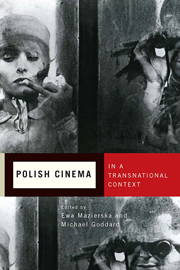Book contents
- Frontmatter
- Contents
- Acknowledgments
- Introduction: Polish Cinema beyond Polish Borders
- Part One The International Reception of Polish Films
- 1 West of the East: Polish and Eastern European Film in the United Kingdom
- 2 The Shifting British Reception of Wajda's Work from Man of Marble to Katyñ
- 3 Affluent Viewers as Global Provincials: The American Reception of Polish Cinema
- 4 Polish Films at the Venice and Cannes Film Festivals: The 1940s, 1950s, and 1960s
- 5 How Polish Is Polish?: Silver City and the National Identity of Documentary Film
- Part Two Polish International Coproductions and Presence in Foreign Films
- Part Three Émigré and Subversive Polish Directors
- Selected Bibliography
- List of Contributors
- Index
4 - Polish Films at the Venice and Cannes Film Festivals: The 1940s, 1950s, and 1960s
from Part One - The International Reception of Polish Films
Published online by Cambridge University Press: 05 April 2014
- Frontmatter
- Contents
- Acknowledgments
- Introduction: Polish Cinema beyond Polish Borders
- Part One The International Reception of Polish Films
- 1 West of the East: Polish and Eastern European Film in the United Kingdom
- 2 The Shifting British Reception of Wajda's Work from Man of Marble to Katyñ
- 3 Affluent Viewers as Global Provincials: The American Reception of Polish Cinema
- 4 Polish Films at the Venice and Cannes Film Festivals: The 1940s, 1950s, and 1960s
- 5 How Polish Is Polish?: Silver City and the National Identity of Documentary Film
- Part Two Polish International Coproductions and Presence in Foreign Films
- Part Three Émigré and Subversive Polish Directors
- Selected Bibliography
- List of Contributors
- Index
Summary
Throughout its postwar history Polish cinema enjoyed a strong presence at various international film festivals on both sides of the Iron Curtain—not only Cannes, Berlin, Venice, Locarno, and San Sebastian, but also Moscow and Karlovy Vary. The careers of individual Polish directors, such as Aleksander Ford, Andrzej Wajda, Jerzy Kawalerowicz, Andrzej Munk, Wojciech Has, Agnieszka Holland, and Krzysztof Kieślowski, among others, were consolidated with the help of these film festivals. However, the two important moments in this period of of Polish cinema history, the Polish school in the 1950s and the Cinema of Moral Concern in the 1970s, did not resonate equally strongly at international film festivals. While the Polish school was a resounding success on the film festival circuit, launched internationally thanks to the 1957 Cannes award-winning screening of Wajda's Kanał (1957), the Cinema of Moral Concern remained virtually unknown abroad as an aesthetic movement and was underrepresented in festival screenings. The exceptions were the films of one of its key directors, Krzysztof Kieślowski, which were regarded as the Eastern European festival discovery throughout the 1980s, making him a household name among foreign art house audiences.
These winding paths of Polish national cinema on the European film festival map are best followed in the context of the history of the film festivals themselves where the early practice of film selection, which overlapped with the success of the Polish school, privileged the national effort at filmmaking over a single auteur filmmaker. In contrast, Kieślowski's success in the 1980s occurred at the time when festival selection became independent from national submissions and when festivals were responsible for making their own programming choices.
- Type
- Chapter
- Information
- Polish Cinema in a Transnational Context , pp. 77 - 94Publisher: Boydell & BrewerPrint publication year: 2014



